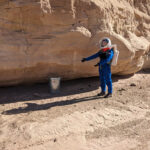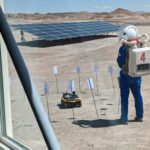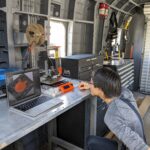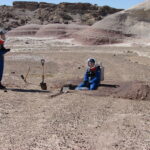Mission Summary
Mission: 297
Dates: April 15 – April 26, 2024
Author: Pawel Sawicki (Commander)
“Welcome to Mars” was the first thing the 297th Mars Desert Research Station crew, named
Janus I, heard when their mission commenced shortly after noon on April 15th. With Janus I being the Roman god of duality, transitions, and beginnings, this opening exclamation by
Mission Support was a fitting ribbon-cutting for a crew where five out of 6 members had never
traversed the analog Martian regolith before.
With such a novel crew, the first handful of sols were especially vital in familiarizing ourselves
with the nominal procedures of the Station. During the beginning timeframe of the mission, the crew made sure to become acquainted with the expected duties of their roles, layout of the
various Station facilities, and functionality of the EVA suits and rovers. This first set of sols also
established the groundwork for the various research projects, with initial objectives completed
related to all projects.
The Janus I crew quickly became accustomed to their Martian home, as the sols gradually
became more habitual and routine. Mornings were often filled with EVAs and afternoons
consisted of report writing, card games (Hanabi, Uno, and President), music courtesy of Dave,
space-themed movies, and a bi-weekly Thursday trivia night. It also turned out that the crew
was composed of world-class cryodessication chefs, albeit they were the only chefs on this
planet. During the 12-sol mission, meals composed of an assortment of cuisines were artfully
crafted: ceviche, crepes, casserole, Japanese curry dish, Jambalaya, Southwestern beans and
rice, spaghetti, soupe au fromage et aux légumes, soy peanut couscous, shoyu ramen, and
vegetable stir fry.
Many of these meals utilized the available GreenHab resources. During the mission, the
GreenHab officer harvested a veritable cornucopia of vegetables: radishes (681 g), cherry
tomatoes (534 g), cucumbers (471 g), red cabbage (309 g), kale (220 g), green onions (53 g),
carrots (45 g), parsley (34 g), sage (12 g), lettuce (6 g), thyme (5 g), and rosemary (3g). Such a plethora of vegetables came as a result of being the last crew to utilize the GreenHab this
season, a privilege which also came with the expected responsibility of tearing down the
GreenHab on our last day. Maintaining the GreenHab during its last few weeks of the season
did not come without added difficulties for the GHO. Due to frequent power shortages, the
automation functionality of the fan was unreliable, resulting in required manual intervention to
maintain the GreenHab internal temperature within a desirable range.
Anomalies were not just present in the GreenHab. As expected of any space station,
maintenance was a primary responsibility of the Crew Engineer – a duty at which they excelled. During the 12-sol mission, the Crew Engineer repaired Suit 2 (stuck valve), Suit 3 (loose
power connection), Suit 4 (missing cable ring), Suit 5 (ventilation electrical connection), Suit 11
(poor battery life), replaced Hab Tunnel zip ties, and tightened key switches on all 4 rovers.
Apart from corrective maintenance, the engineer made sure that the Hab was functioning
nominally by monitoring and emptying the toilet, calculating water levels, and inspecting the
entirety of the station’s facilities in the midst of uncertain power supply.
While the crew masterfully executed their positional duties, they never let up on successfully
conducting their research. Janus I investigated many sub-disciplines of science and
engineering, specifically geological field spectroscopy, operations of nuclear power systems,
developing smart sensor-based systems, and Martian-appropriate advancements in IT, and
were participants in research projects pertaining to isolated, confined, and extreme
environments and human-robotic interactions. With three of these projects relying heavily on
EVAs for expanding the sample size, the Janus I crew conducted an astounding total of 18
EVAs, which lasted a cumulative 42 hours. For more insight into the many achieved research
objectives of Mission 297, it is recommended to read the End-of-Mission Research Report.
As the T- minus clock winds down for the return launch, with a heavy-heart we say goodbye to
our Martian home of 12-sols and look forward to hearing “Welcome back to Earth”.









You must be logged in to post a comment.